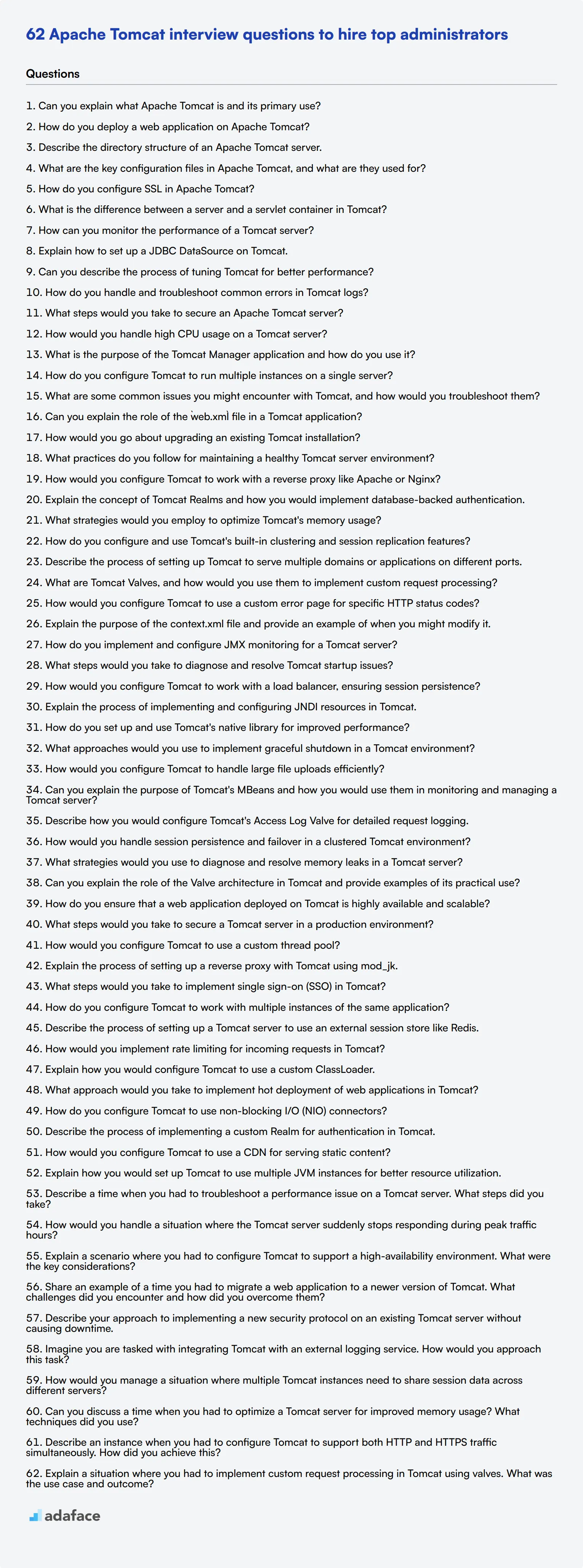Conducting effective interviews is crucial for finding top-notch Apache Tomcat administrators who can manage and optimize server applications. Utilizing well-crafted questions can help you evaluate the candidates' expertise effectively and prevent the adverse effects of a bad hire, such as project delays and increased costs.
This blog post will provide you with a curated list of Apache Tomcat interview questions tailored to different experience levels. You'll find questions to ask junior, mid-tier, and senior administrators for a comprehensive understanding of their skills and knowledge.
By using this guide, you can streamline your interview process and hire the best talent for your organization. For a more efficient assessment, consider integrating our Apache Tomcat Online Test before conducting interviews.
Table of contents
10 Apache Tomcat interview questions to initiate the interview
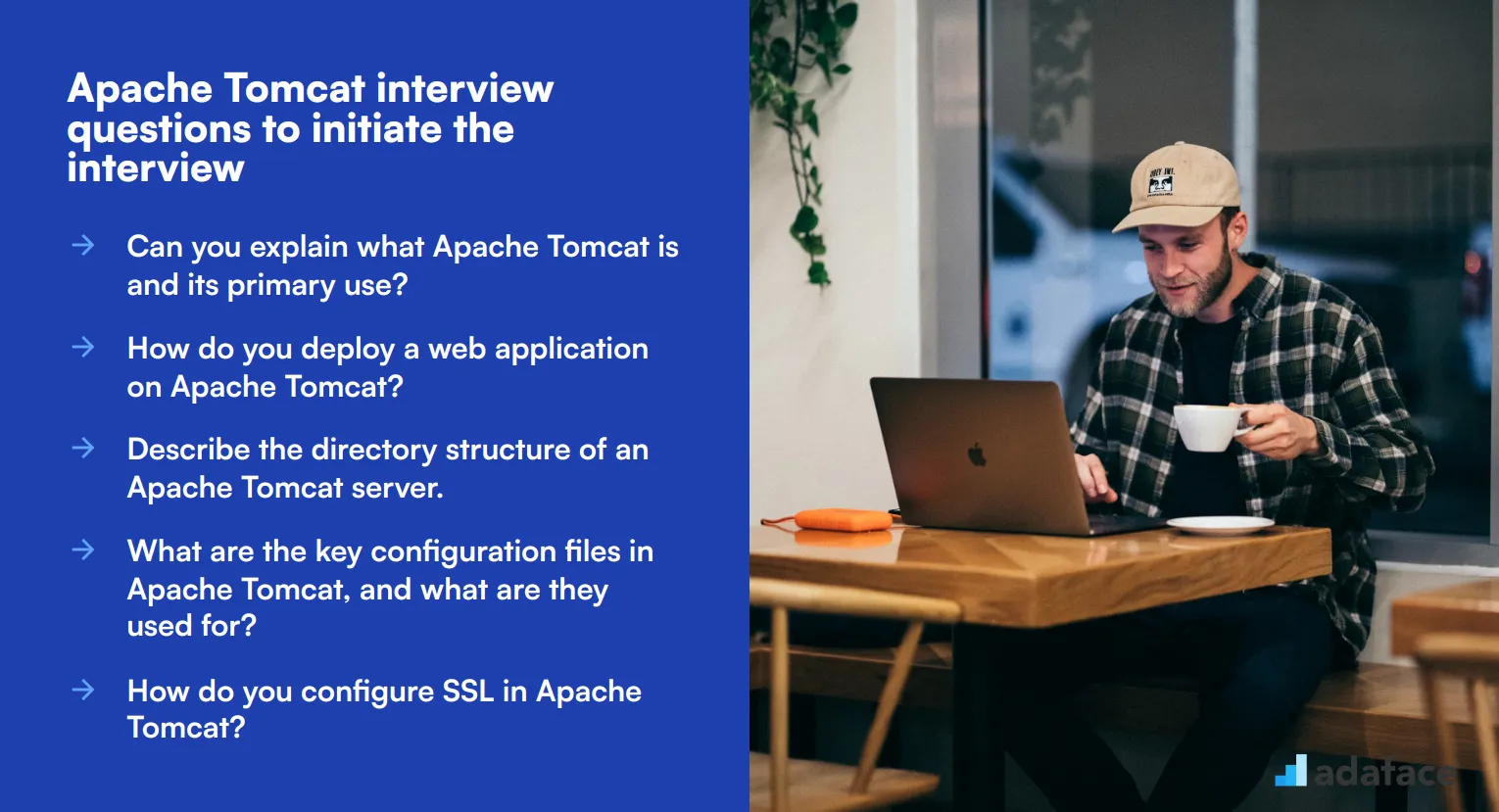
To determine whether your applicants have the right skills to work with Apache Tomcat, ask them some of these 10 interview questions about processes and actions. These questions will help you assess their technical understanding and problem-solving abilities, ensuring they are a perfect fit for roles like software engineer.
- Can you explain what Apache Tomcat is and its primary use?
- How do you deploy a web application on Apache Tomcat?
- Describe the directory structure of an Apache Tomcat server.
- What are the key configuration files in Apache Tomcat, and what are they used for?
- How do you configure SSL in Apache Tomcat?
- What is the difference between a server and a servlet container in Tomcat?
- How can you monitor the performance of a Tomcat server?
- Explain how to set up a JDBC DataSource on Tomcat.
- Can you describe the process of tuning Tomcat for better performance?
- How do you handle and troubleshoot common errors in Tomcat logs?
8 Apache Tomcat interview questions and answers to evaluate junior administrators
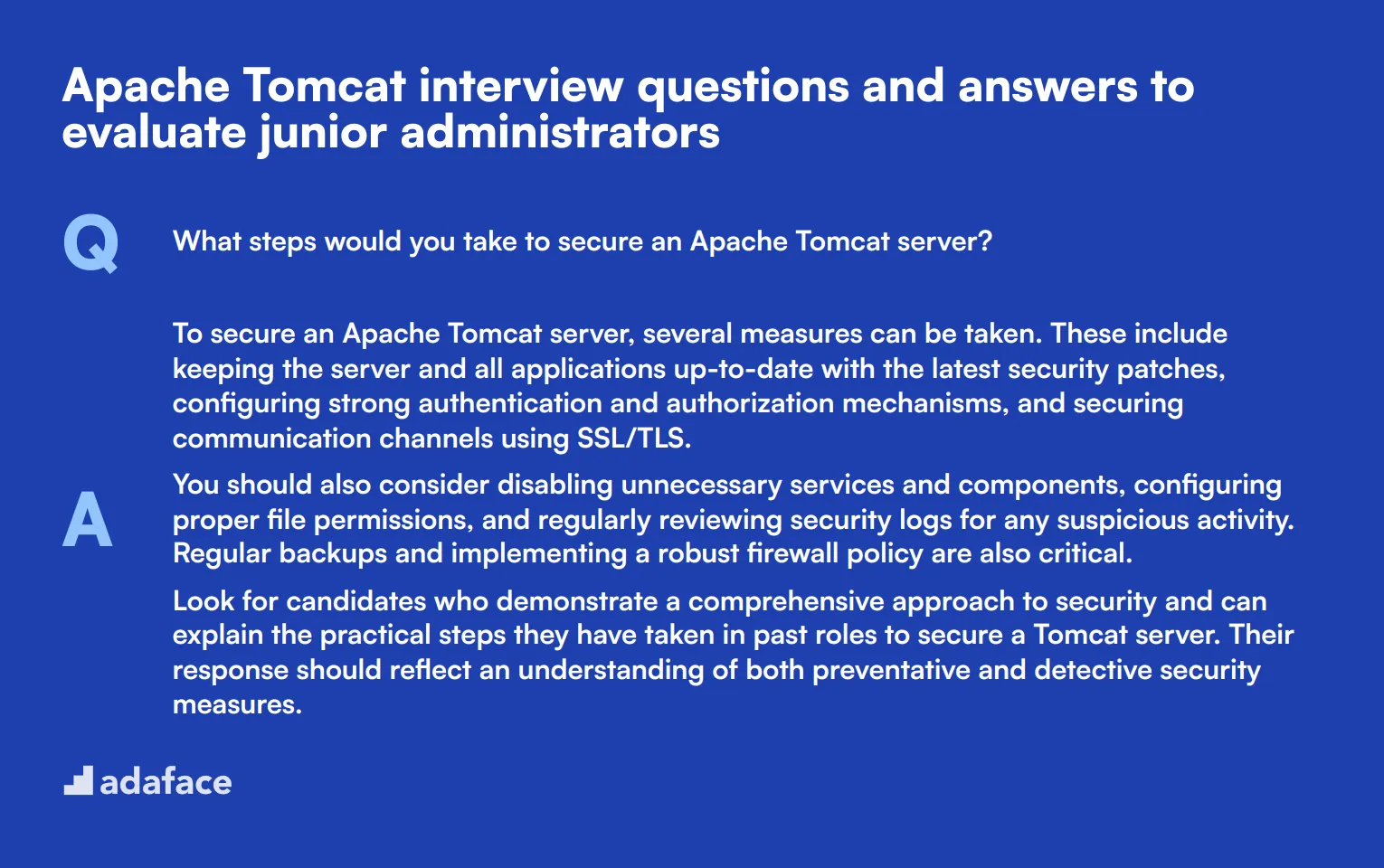
To determine whether your junior administrators are ready to handle Apache Tomcat, ask them some of these 8 tailored interview questions. These questions will help you evaluate their understanding of Tomcat's core functionalities and their ability to maintain and troubleshoot the server.
1. What steps would you take to secure an Apache Tomcat server?
To secure an Apache Tomcat server, several measures can be taken. These include keeping the server and all applications up-to-date with the latest security patches, configuring strong authentication and authorization mechanisms, and securing communication channels using SSL/TLS.
You should also consider disabling unnecessary services and components, configuring proper file permissions, and regularly reviewing security logs for any suspicious activity. Regular backups and implementing a robust firewall policy are also critical.
Look for candidates who demonstrate a comprehensive approach to security and can explain the practical steps they have taken in past roles to secure a Tomcat server. Their response should reflect an understanding of both preventative and detective security measures.
2. How would you handle high CPU usage on a Tomcat server?
High CPU usage on a Tomcat server can be addressed by first identifying the root cause. This can be done by analyzing logs and using monitoring tools to pinpoint which processes or applications are consuming excessive resources. Once identified, optimizing the code, updating configurations, or scaling the application horizontally might be necessary.
It is also important to check for memory leaks and ensure that the Tomcat server is configured with appropriate memory and CPU settings. Load balancing and fine-tuning JVM parameters can also help in mitigating high CPU usage.
An ideal candidate should discuss a methodical approach to troubleshooting and optimizing performance. They should mention specific tools and techniques they use to monitor and diagnose issues, showing their practical experience in maintaining server health.
3. What is the purpose of the Tomcat Manager application and how do you use it?
The Tomcat Manager application is a web-based interface that allows administrators to manage the deployment of web applications on a Tomcat server. It provides functionalities such as starting, stopping, reloading, and deploying web applications, as well as viewing server status and diagnostics.
To use the Manager application, you need to ensure that the user has the necessary roles assigned in the tomcat-users.xml file. Once logged in, you can manage your applications through a user-friendly interface or via HTTP requests for automation purposes.
Candidates should demonstrate familiarity with the Manager application’s features and discuss how they have used it in their previous roles. Look for an understanding of both the GUI and command-line functionalities.
4. How do you configure Tomcat to run multiple instances on a single server?
Running multiple instances of Tomcat on a single server involves creating separate directories for each instance and configuring them to use different ports. Each instance should have its own set of configuration files and logs to avoid conflicts.
This setup typically requires modifying the server.xml file for each instance to specify unique port numbers for the HTTP connector, shutdown port, and AJP connector. You may also need to adjust environment variables and startup scripts.
An ideal response will include practical steps taken to achieve this setup, showcasing the candidate's ability to manage multiple instances efficiently. Look for detailed explanations on configuration adjustments and troubleshooting potential conflicts.
5. What are some common issues you might encounter with Tomcat, and how would you troubleshoot them?
Common issues with Tomcat include memory leaks, high CPU usage, slow response times, and application deployment failures. Troubleshooting these issues involves a systematic approach, starting with checking the logs for errors and warnings.
Using monitoring tools to analyze system performance, reviewing application code for inefficiencies, and ensuring proper configuration settings are also crucial steps. Sometimes, issues may arise from external dependencies, so checking network configurations and database connections might be necessary.
Candidates should describe their problem-solving process and mention specific tools they use for monitoring and diagnostics. Their response should reflect experience in identifying root causes and implementing effective solutions.
6. Can you explain the role of the `web.xml` file in a Tomcat application?
The web.xml file, also known as the deployment descriptor, is an essential component of a Tomcat application. It defines the configuration settings for the web application, including servlet mappings, session parameters, security constraints, and error handling configurations.
By editing the web.xml file, administrators can control how requests are routed, specify initialization parameters for servlets, and set up listeners and filters. It acts as a bridge between the application and the server, ensuring that runtime behavior aligns with defined configurations.
Candidates should demonstrate a clear understanding of the web.xml file's significance and provide examples of how they have used it to configure web applications. Their response should highlight their ability to manage application settings effectively.
7. How would you go about upgrading an existing Tomcat installation?
Upgrading an existing Tomcat installation involves several steps to ensure a smooth transition. First, it's important to back up the current configuration files, web applications, and any custom scripts. Then, download the latest Tomcat version and replace the old binaries with the new ones.
After the upgrade, migrate the configuration files and web applications to the new installation, making sure to test each component thoroughly. Review the release notes for any changes that might affect your setup, and adjust configurations as needed.
Look for candidates who emphasize the importance of thorough testing and backup procedures. Their response should show an understanding of the upgrade process and the steps needed to minimize downtime and data loss.
8. What practices do you follow for maintaining a healthy Tomcat server environment?
Maintaining a healthy Tomcat server environment involves regular monitoring, applying updates and patches, and performing routine backups. Using monitoring tools to keep track of server performance and resource usage is essential for early detection of potential issues.
Regularly reviewing and tuning configurations, cleaning up unused applications, and ensuring that security settings are up-to-date are also important practices. Documenting configurations and changes helps in maintaining consistency and ease of troubleshooting.
Candidates should discuss their approach to proactive maintenance and the tools they use for monitoring and management. An ideal response will showcase their commitment to maintaining server health and preventing issues before they escalate.
15 intermediate Apache Tomcat interview questions and answers to ask mid-tier administrators.
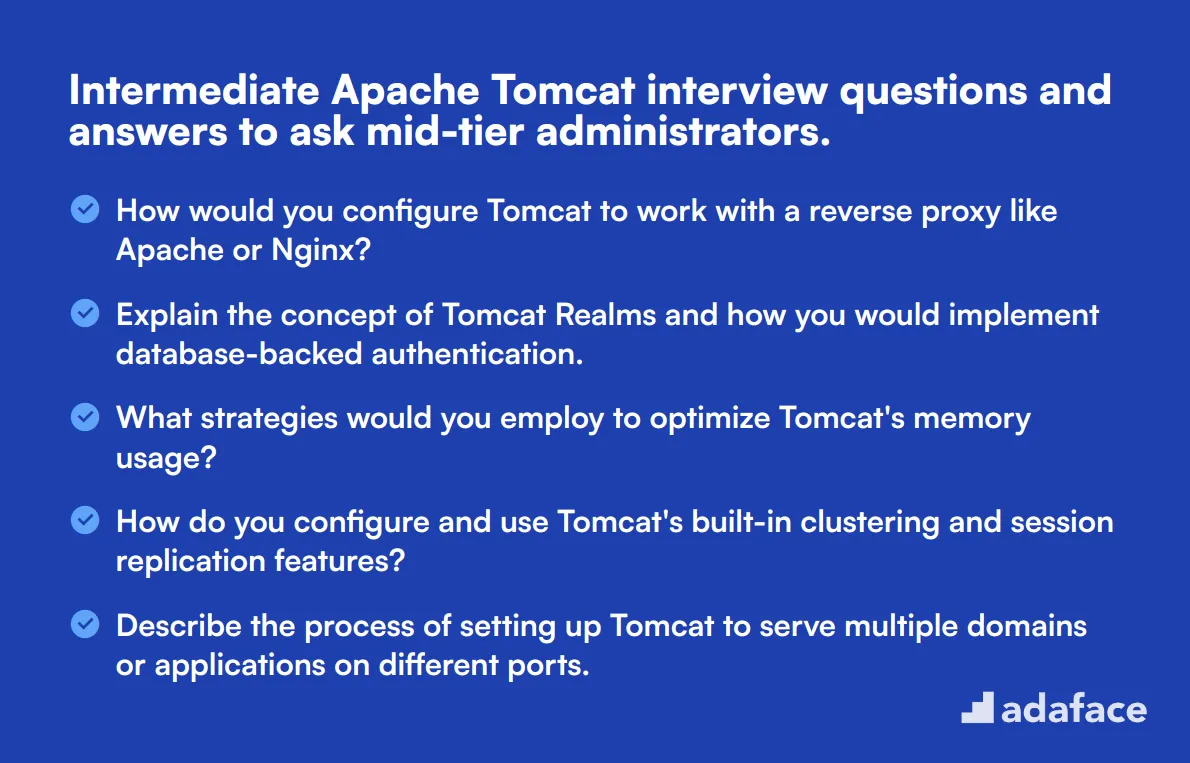
To assess the intermediate-level skills of Apache Tomcat administrators, use these 15 targeted interview questions. These questions are designed to evaluate a candidate's practical knowledge and troubleshooting abilities, helping you identify those who can effectively manage and optimize Tomcat environments.
- How would you configure Tomcat to work with a reverse proxy like Apache or Nginx?
- Explain the concept of Tomcat Realms and how you would implement database-backed authentication.
- What strategies would you employ to optimize Tomcat's memory usage?
- How do you configure and use Tomcat's built-in clustering and session replication features?
- Describe the process of setting up Tomcat to serve multiple domains or applications on different ports.
- What are Tomcat Valves, and how would you use them to implement custom request processing?
- How would you configure Tomcat to use a custom error page for specific HTTP status codes?
- Explain the purpose of the context.xml file and provide an example of when you might modify it.
- How do you implement and configure JMX monitoring for a Tomcat server?
- What steps would you take to diagnose and resolve Tomcat startup issues?
- How would you configure Tomcat to work with a load balancer, ensuring session persistence?
- Explain the process of implementing and configuring JNDI resources in Tomcat.
- How do you set up and use Tomcat's native library for improved performance?
- What approaches would you use to implement graceful shutdown in a Tomcat environment?
- How would you configure Tomcat to handle large file uploads efficiently?
7 advanced Apache Tomcat interview questions and answers to evaluate senior administrators
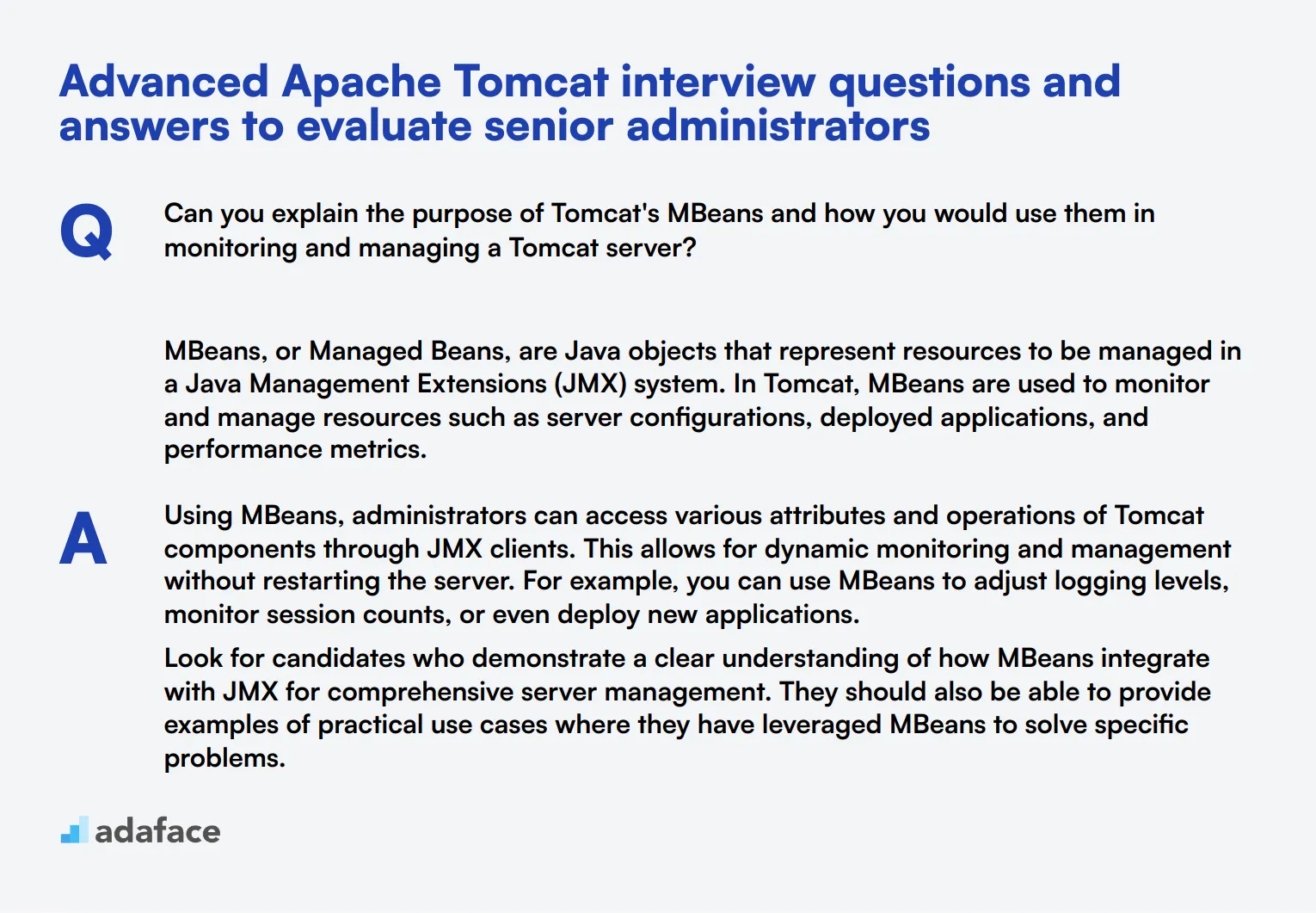
To evaluate whether senior administrators have an in-depth understanding of Apache Tomcat, it's crucial to ask advanced questions that go beyond basic concepts. This list of advanced Apache Tomcat interview questions is designed to help you identify candidates who can manage and optimize Tomcat in a complex, real-world environment.
1. Can you explain the purpose of Tomcat's MBeans and how you would use them in monitoring and managing a Tomcat server?
MBeans, or Managed Beans, are Java objects that represent resources to be managed in a Java Management Extensions (JMX) system. In Tomcat, MBeans are used to monitor and manage resources such as server configurations, deployed applications, and performance metrics.
Using MBeans, administrators can access various attributes and operations of Tomcat components through JMX clients. This allows for dynamic monitoring and management without restarting the server. For example, you can use MBeans to adjust logging levels, monitor session counts, or even deploy new applications.
Look for candidates who demonstrate a clear understanding of how MBeans integrate with JMX for comprehensive server management. They should also be able to provide examples of practical use cases where they have leveraged MBeans to solve specific problems.
2. Describe how you would configure Tomcat's Access Log Valve for detailed request logging.
The Access Log Valve in Tomcat is a crucial component for logging incoming HTTP requests. It captures details like the request URL, response status, and processing time, which are invaluable for debugging and monitoring.
To configure it, you typically edit the server.xml file and add an AccessLogValve element within the Host or Engine elements. You can customize the logging pattern to include specific attributes such as client IP, request method, and user session ID.
An ideal candidate should be able to explain how to configure the Access Log Valve to meet specific logging requirements and discuss scenarios in which detailed request logs have been essential for troubleshooting.
3. How would you handle session persistence and failover in a clustered Tomcat environment?
Session persistence and failover are critical in a clustered Tomcat environment to ensure that user sessions are not lost when a server goes down. Tomcat provides several options for session persistence, including using in-memory replication, file-based storage, or a database.
In-memory replication involves sharing session data across all nodes in the cluster. This method is fast but can be memory-intensive. File-based and database storage are more scalable but may introduce latency. Each method has its trade-offs, and the choice depends on the specific requirements and constraints of the application.
Candidates should describe their experience with configuring and managing session persistence in a clustered environment. Look for their ability to weigh the pros and cons of different persistence methods and choose the most suitable one for a given scenario.
4. What strategies would you use to diagnose and resolve memory leaks in a Tomcat server?
Memory leaks in a Tomcat server can lead to performance degradation and eventually cause the server to crash. To diagnose memory leaks, you can use tools like JVisualVM, Eclipse Memory Analyzer, or any other JVM profiling tool to monitor memory usage and identify objects that are not being garbage collected.
Once identified, the next step is to analyze the code and configuration to locate the source of the leak. Common culprits include improperly managed session objects, static fields holding references, and third-party libraries. Fixing the leak may involve code changes, configuration adjustments, or even updates to third-party libraries.
A strong candidate should be familiar with the tools and techniques for diagnosing memory leaks and have experience in resolving such issues. They should be able to provide examples of past incidents and how they successfully mitigated them.
5. Can you explain the role of the Valve architecture in Tomcat and provide examples of its practical use?
The Valve architecture in Tomcat allows you to intercept and process HTTP requests and responses at various points in the request-processing pipeline. Valves are configured in the server.xml file and can be applied at the Engine, Host, or Context level.
Common uses of Valves include access logging, IP filtering, and single sign-on. For example, the RemoteAddrValve can be used to restrict access to certain IP addresses, while the SingleSignOn valve enables single sign-on across multiple web applications within the same host.
Ideal candidates should be able to discuss specific use cases where they have implemented custom Valves to solve particular challenges. They should also understand the configuration and lifecycle of Valves within the Tomcat environment.
6. How do you ensure that a web application deployed on Tomcat is highly available and scalable?
Ensuring high availability and scalability of a web application on Tomcat involves several strategies, including load balancing, clustering, and resource optimization. Load balancing distributes incoming requests across multiple Tomcat instances, which can be achieved using software load balancers like HAProxy or hardware solutions.
Clustering ensures that session data is replicated across multiple nodes, providing failover capabilities. Additionally, optimizing resource usage by tuning JVM parameters, configuring connection pooling, and using efficient coding practices is essential.
Candidates should demonstrate a comprehensive approach to achieving high availability and scalability, mentioning their experience with load balancers, clustering configurations, and performance optimization techniques. Look for examples of how they have implemented these strategies in previous projects.
7. What steps would you take to secure a Tomcat server in a production environment?
Securing a Tomcat server in a production environment involves multiple layers of defense. Basic steps include updating Tomcat to the latest version, disabling unnecessary services, and configuring strong password policies for the Tomcat Manager and Host Manager.
Other security measures include enabling SSL/TLS for encrypted communication, configuring security roles and permissions, and using security headers to protect against common web vulnerabilities like XSS and CSRF. Additionally, implementing network security measures such as firewalls and intrusion detection systems is crucial.
An ideal candidate should have a well-rounded understanding of Tomcat security best practices and be able to discuss specific measures they have implemented to secure a production environment. Look for their ability to provide detailed examples and explain the rationale behind their security strategies.
12 Apache Tomcat interview questions about configuration and management
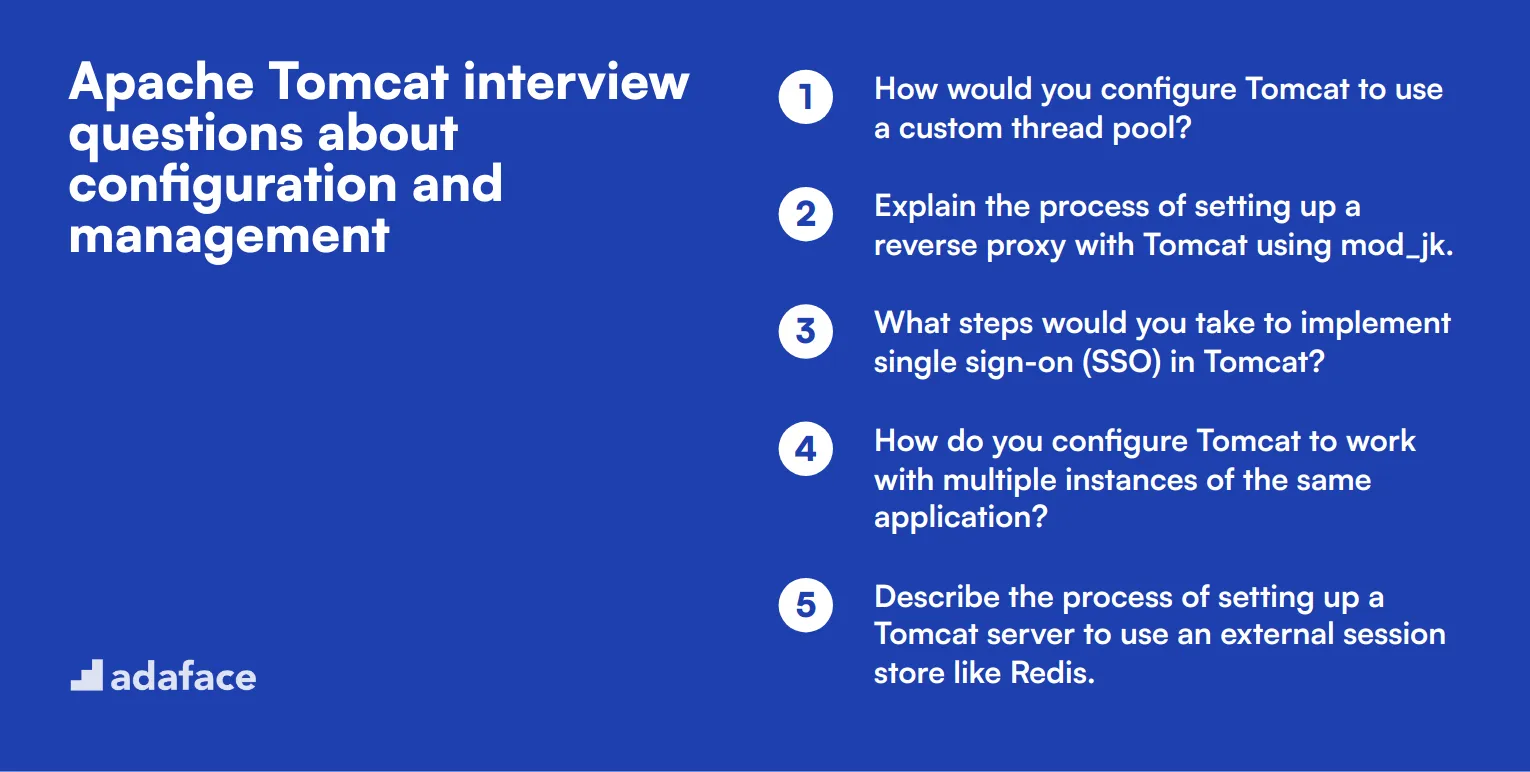
To assess a candidate's expertise in configuring and managing Apache Tomcat, use these 12 interview questions. They will help you evaluate the applicant's skills in handling complex Tomcat setups and troubleshooting common issues.
- How would you configure Tomcat to use a custom thread pool?
- Explain the process of setting up a reverse proxy with Tomcat using mod_jk.
- What steps would you take to implement single sign-on (SSO) in Tomcat?
- How do you configure Tomcat to work with multiple instances of the same application?
- Describe the process of setting up a Tomcat server to use an external session store like Redis.
- How would you implement rate limiting for incoming requests in Tomcat?
- Explain how you would configure Tomcat to use a custom ClassLoader.
- What approach would you take to implement hot deployment of web applications in Tomcat?
- How do you configure Tomcat to use non-blocking I/O (NIO) connectors?
- Describe the process of implementing a custom Realm for authentication in Tomcat.
- How would you configure Tomcat to use a CDN for serving static content?
- Explain how you would set up Tomcat to use multiple JVM instances for better resource utilization.
10 situational Apache Tomcat interview questions for hiring top administrators
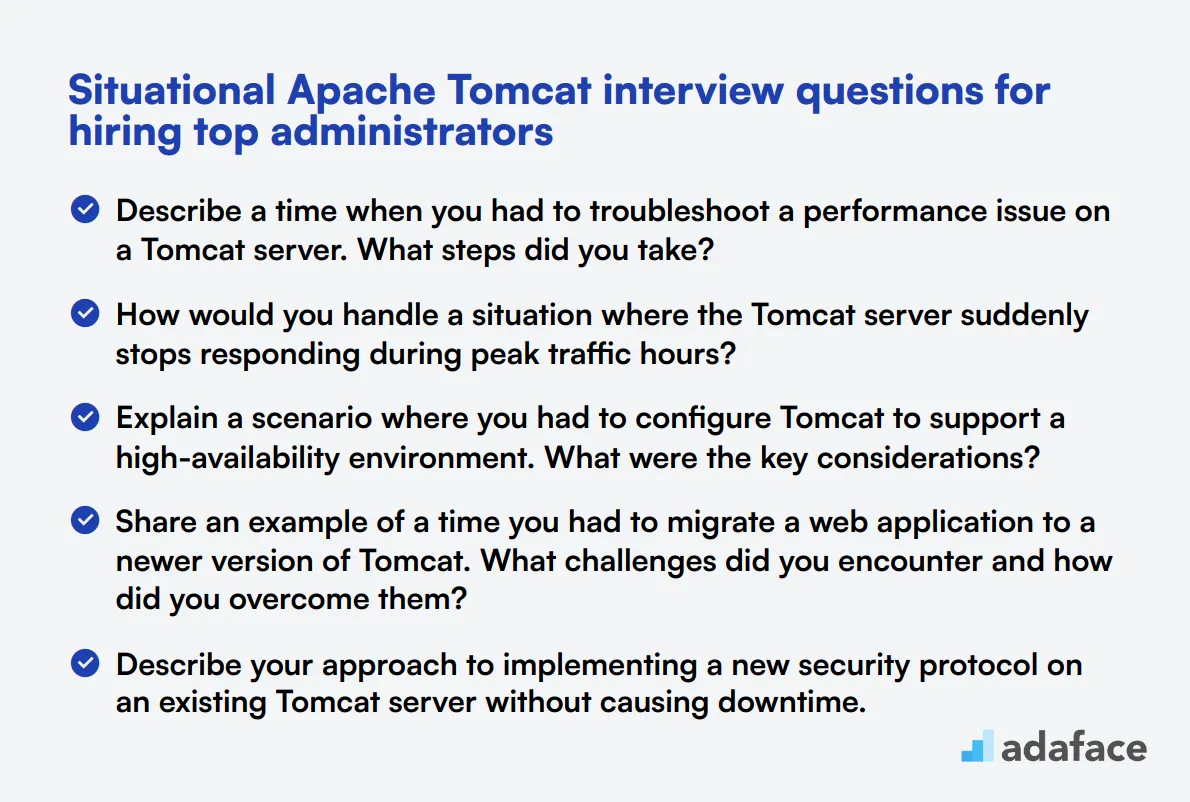
To ensure you hire top-notch Apache Tomcat administrators, use these situational interview questions. These questions will help you gauge the candidates' problem-solving abilities and practical experience, ensuring they can handle real-world challenges efficiently. For a more tailored approach, consider reviewing our Java developer job description.
- Describe a time when you had to troubleshoot a performance issue on a Tomcat server. What steps did you take?
- How would you handle a situation where the Tomcat server suddenly stops responding during peak traffic hours?
- Explain a scenario where you had to configure Tomcat to support a high-availability environment. What were the key considerations?
- Share an example of a time you had to migrate a web application to a newer version of Tomcat. What challenges did you encounter and how did you overcome them?
- Describe your approach to implementing a new security protocol on an existing Tomcat server without causing downtime.
- Imagine you are tasked with integrating Tomcat with an external logging service. How would you approach this task?
- How would you manage a situation where multiple Tomcat instances need to share session data across different servers?
- Can you discuss a time when you had to optimize a Tomcat server for improved memory usage? What techniques did you use?
- Describe an instance when you had to configure Tomcat to support both HTTP and HTTPS traffic simultaneously. How did you achieve this?
- Explain a situation where you had to implement custom request processing in Tomcat using valves. What was the use case and outcome?
Which Apache Tomcat skills should you evaluate during the interview phase?
While it's impossible to assess every aspect of a candidate's Apache Tomcat expertise in a single interview, focusing on core skills is crucial. Here are the key areas to evaluate during the interview process for Apache Tomcat administrators.
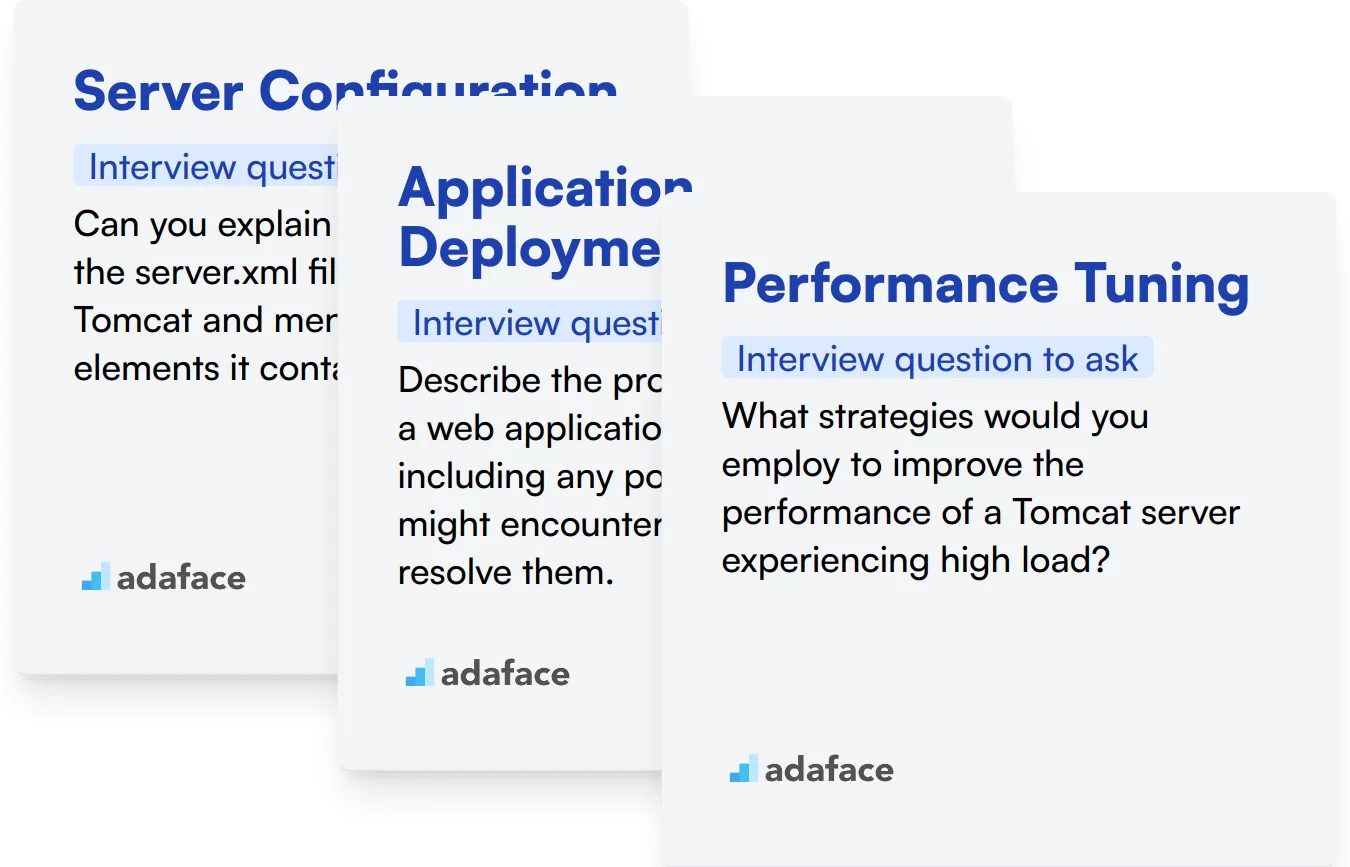
Server Configuration
Server configuration is a fundamental skill for Apache Tomcat administrators. It involves setting up and optimizing the server environment, which directly impacts application performance and security.
To assess this skill, consider using an Apache Tomcat online test that includes multiple-choice questions on server configuration topics.
You can also ask targeted interview questions to gauge the candidate's understanding of server configuration. Here's an example:
Can you explain the purpose of the server.xml file in Apache Tomcat and mention a few key elements it contains?
Look for answers that demonstrate knowledge of the server.xml file as the main configuration file. The candidate should mention elements like Connectors, Engine, Host, and Context, showing their understanding of Tomcat's architecture.
Application Deployment
Efficient application deployment is critical for maintaining a smooth-running Tomcat environment. This skill involves understanding deployment methods, troubleshooting deployment issues, and managing application lifecycles.
An assessment test with questions on WAR file deployment, context paths, and hot deployment can help evaluate this skill effectively.
To further assess this skill, consider asking a question like:
Describe the process of deploying a web application in Tomcat, including any potential issues you might encounter and how to resolve them.
Look for answers that cover methods like using the manager app, deploying WAR files, and setting up context files. The candidate should also mention common issues like classloading problems or context conflicts, and ways to troubleshoot them.
Performance Tuning
Performance tuning is essential for optimizing Tomcat's operation. This skill involves identifying bottlenecks, adjusting server parameters, and implementing best practices for enhanced performance.
Include questions about JVM tuning, connection pooling, and caching strategies in your assessment to evaluate this skill.
To delve deeper into the candidate's performance tuning knowledge, ask a question like:
What strategies would you employ to improve the performance of a Tomcat server experiencing high load?
Look for answers that discuss JVM memory settings, thread pool configurations, database connection pooling, and caching mechanisms. The candidate should demonstrate an understanding of how these factors impact Tomcat's performance under load.
Hire the Best Apache Tomcat Administrators with Adaface
If you're looking to hire someone with Apache Tomcat skills, it's important to ensure they truly possess the necessary expertise.
The best way to evaluate these skills is by using targeted skill tests. Check out our Apache Tomcat Online Test and DevOps Online Test.
By utilizing these tests, you can shortlist the best candidates and invite them for interviews.
Next, head over to our signup page to start assessing candidates or visit our online assessment platform for more information.
Apache Tomcat Test
Download Apache Tomcat interview questions template in multiple formats
Apache Tomcat Interview Questions FAQs
The questions cover junior, mid-tier, and senior administrator skill levels, as well as configuration, management, and situational scenarios.
The post includes 8 questions for junior admins, 15 for mid-tier admins, 7 for senior admins, and additional questions on configuration, management, and situational topics.
Yes, the questions can be used for verbal interviews and can also guide practical assessments of Apache Tomcat administration skills.
It's recommended to review and update the questions annually or when significant changes occur in Apache Tomcat technology or best practices.

40 min skill tests.
No trick questions.
Accurate shortlisting.
We make it easy for you to find the best candidates in your pipeline with a 40 min skills test.
Try for freeRelated posts
Free resources




